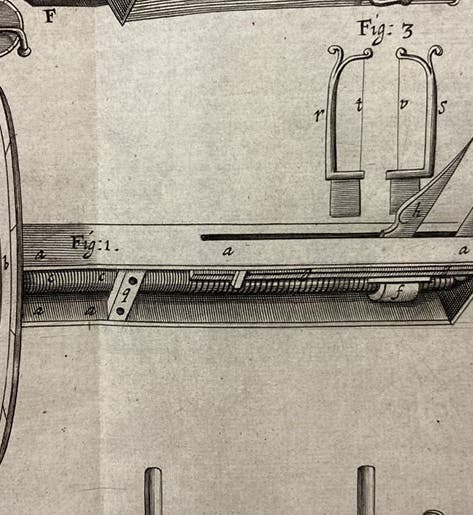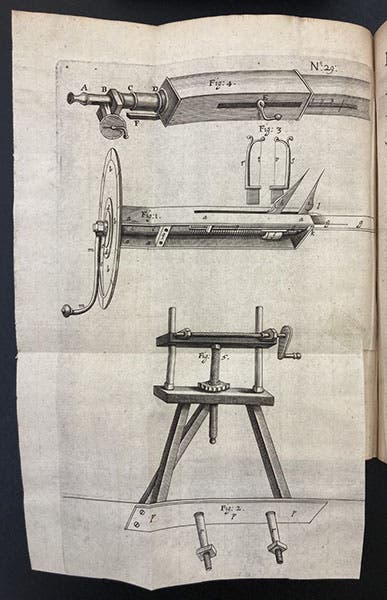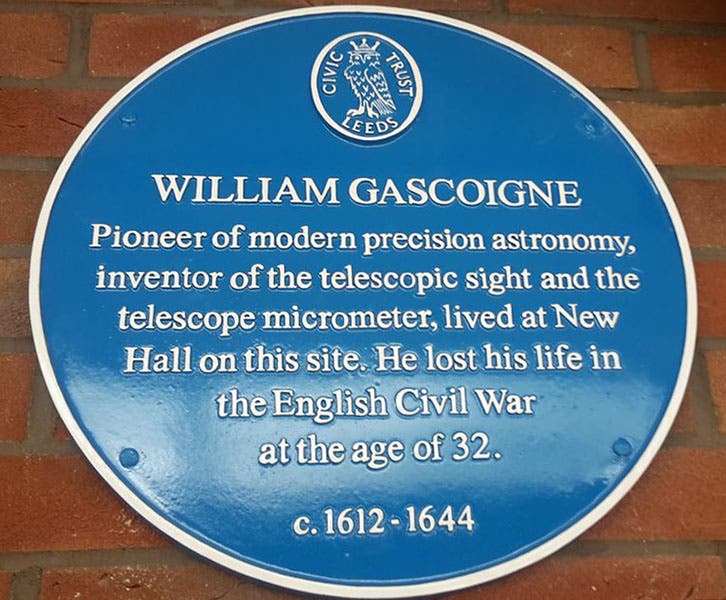Scientist of the Day - William Gascoigne
William Gascoigne, an English astronomer, died July 2, 1644; he was about 32 years old. On Dec. 4, 2014, in the first few months of our Scientist of the Day series, we wrote about two Lancashire astronomers, William Crabtree and Jeremiah Horrocks, who first successfully observed a transit of Venus in 1639. Crabtree and Horrocks were two members of a foursome who are often referred to as the "North Country" astronomers, and Gascoigne, born in Yorkshire, was the third member of the group. The three young men essentially invented precision observational astronomy in England in the early 1640s, and via their patron, Richard Towneley (the fourth member), they gave a remote and delayed jumpstart to the great English astronomical tradition that began with Robert Hooke and John Flamsteed in the late 1660s. Towneley was needed to make the connection because the first three all died at young ages between 1641 and 1644, and North Country astronomy came to an abrupt hiatus, until it re-emerged in London, thanks to Towneley.
Gascoigne was important for two inventions that greatly improved the utility of the telescope as a measuring instrument (as opposed to an observing instrument). One was the telescopic sight. Gascoigne found that if he replaced the naked-eye sight of a quadrant or sextant with a telescopic sight containing cross-hairs, the accuracy of the observations was greatly improved. His other invention was the astronomical micrometer. This was an ingenious device that was inserted in front of the eyepiece of a telescope, and consisted of two vertical needles or wires, with one of them adjustable by means of a screw. With the micrometer, it was possible to measure, for example, the diameter of the moon through the telescope, by putting the left-hand needle against one edge of the moon and turning the screw to bring the other needle next to the right-hand edge. By counting the turns of the screw, one could know precisely the distance between the two needles, and thus the exact angular diameter of the moon. The micrometer could similarly be used to measure the diameter of a planet, or the distance between two stars. It would change the entire nature of observational astronomy – eventually. Crabtree marveled at Gascoigne's invention in some of his letters, and so did Towneley, which was a good thing, because Gascoigne died shortly thereafter, in the Battle of Marston Moor in the English Civil War. When, in the 1660s, the French reinvented the micrometer, it was Towneley, in a letter to the Royal Society in 1667, who in the strongest terms defended the originality and priority of his North countryman. The surviving letters have confirmed Gascoigne’s priority.
In a diagram that was drawn by Robert Hooke to accompany an article in 1667, we can see several views of Gascoigne's micrometer (second image, above). At the top, the eyepiece is on the left, and you can just see a small dial and crank sticking out of the eyepiece – that is the handle of the micrometer screw. In the center view, the micrometer has been removed and greatly enlarged, and one can see the two needle sights (and a variant with two wires), as well as the screws. We have provided a detail of the micrometer as our first image.
Gascoigne’s telescopic sights with crosshairs were adopted by John Flamsteed, the Astronomer Royal, for his instruments at Greenwich Observatory, both for his sextants and his mural quadrant. Our third image (just above) is a headpiece from Flamsteed’s Historia coelestis, the unauthorized 1712 edition, which shows his sextant, from both sides. The telescopic sight is the moveable tube near the upper edge of the sextant in the left-hand view.
There is no known portrait of Gascoigne; the several that you can find on the internet are undocumented. But Gascoigne does have a blue plaque, now; it was installed at the site of his former house in Leeds in 2018 (fourth image, above).
Dr. William B. Ashworth, Jr., Consultant for the History of Science, Linda Hall Library and Associate Professor emeritus, Department of History, University of Missouri-Kansas City. Comments or corrections are welcome; please direct to ashworthw@umkc.edu.









